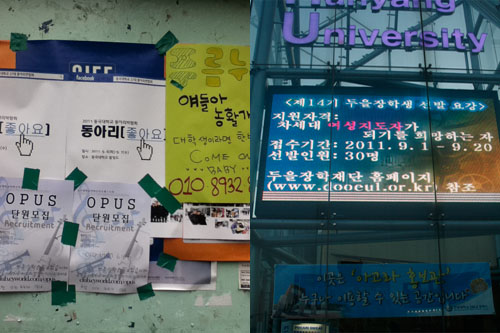University campus is filled with various outdoor banners, posters. Most of them are made by students to advertise their club; others are for companies and brand names. It seems they are one of the most outstanding methods to target university students, directly coming into the sight to the campus. 
▲ University bulletins are often marred by various advertisements(left). In Dongguk University, students grumbles that there are small bulletins in the campus. Meanwhile, Hanyang University sets up a large LED screen that students freely upload their advertisements(right).
Outdoor banners and posters have a long history on university campuses. Decades ago, they were the main method to give notice, express opinions, and share ideas among university students. Since student newspapers were under the censorship of the military government, hand-written posters played a role in gathering the ideas of many students.
Now poster-notices have lost a lot of their power and have given way to other methods of communication like the internet. But hand-written posters still make their way to university campuses. Young generations not only make unique artwork on the hand-written posters, but also criticize some school authorities’ unfair policies.
Kim Ye-seul of Korea University has a story. She posted a long hand-written poster on the school wall, which criticized the current educational system and harsh competition in Korea. Then, she voluntarily left the school, shocking her fellow students. This shows that hand-written posters are still alive and a powerful influence among students.
Park Mi-jung, a student of Konkuk University, said “Hand-written posters and banners on campus are the core culture of university life. Often you can find neologism expressions in posters. That’s really funny.” She added that “Sometimes, some posters advertise school events quicker than internet notices.”
During student elections, traditionally conducted election pledges and hand-written posters stay on the walls. Some voters may feel that hand-written posters are more appealing and give more credibility to candidates.
Thriving posters, however, have caused competition and have spoiled the beauty of the campuses. Very often, campus bulletins are marred by various advertisements like club recruitment, boarding houses, and company brands.
For this reason, posters have no space and this has resulted in removing existing posters or attaching posters on top of posters already glued on the walls. Cleaning workers grumble that they have to remove a slew of posters at the beginning of every semester. Students also complain that their posters are removed so easily and rush again to post their advertisements.
At one time, the student council of Dongguk University publicly launched a campaign that students were to specify their pickup dates and dispose of their posters after this time. It seems, however, there are no more students who remember this old campaign, and the council has changed.
In Dongguk, some students also suggest that bulletins are not exposed to the students properly, and bulletins are small in numbers. Many say that some posters ruin the campus, as they are not in their spots and scattered around the campus.
More bad news is that one banner made a conflict between the school and the student council last year. The student council made a hand-written banner to protest the rising of tuition fees. The banner was in big red letters and this irritated the school during the time of freshman entrance exams. The school made janitors take down the banners.
Now, some universities in Seoul have taken action against the slew of posters. Hankuk University of Foreign Studies (HUFS) has set up large electronic displays where students can easily find in the middle of the campus. Chung-ang and Sung-sil, also simplified their information delivery systems and have used such digital methods.
In the case of Hanyang University, digital posters are everywhere. Every building of each department has devices for advertising. Students can easily upload their advertising slogan. These will be shown on the large electronic displays which are located at the entrance of the campus and Hanyang Plaza where most students visit and pass by at least once a day.
The use of LED lights has also saved on energy consumption and the amount of energy used can be seen at the front gate. Jung Kyu-sik, the manager of general affairs of Hanyang University ERICA campus, said “LED shows the exact amount of energy consumption, it arouses students feeling of thriftiness. With the amount of savings we can return to the students in cash.”
Students’ moods have shown satisfaction. They have noticed scattered posters gradually disappearing. LED makes feeling the campus feel tidy.
Kang Tae-wook, a student of Han-yang University, said that “After the LED build up, it is easy to see that the campus has changed. It is clean, and there are no more scraps of advertisements.”
It remains to be seen whether LED screens will truly replace all of the poster and banners and wane the competition of the slews of advertisement. Dongguk has green and clean roof gardens on every building. Shouldn’t they also work to clean up the rest of the campus?

